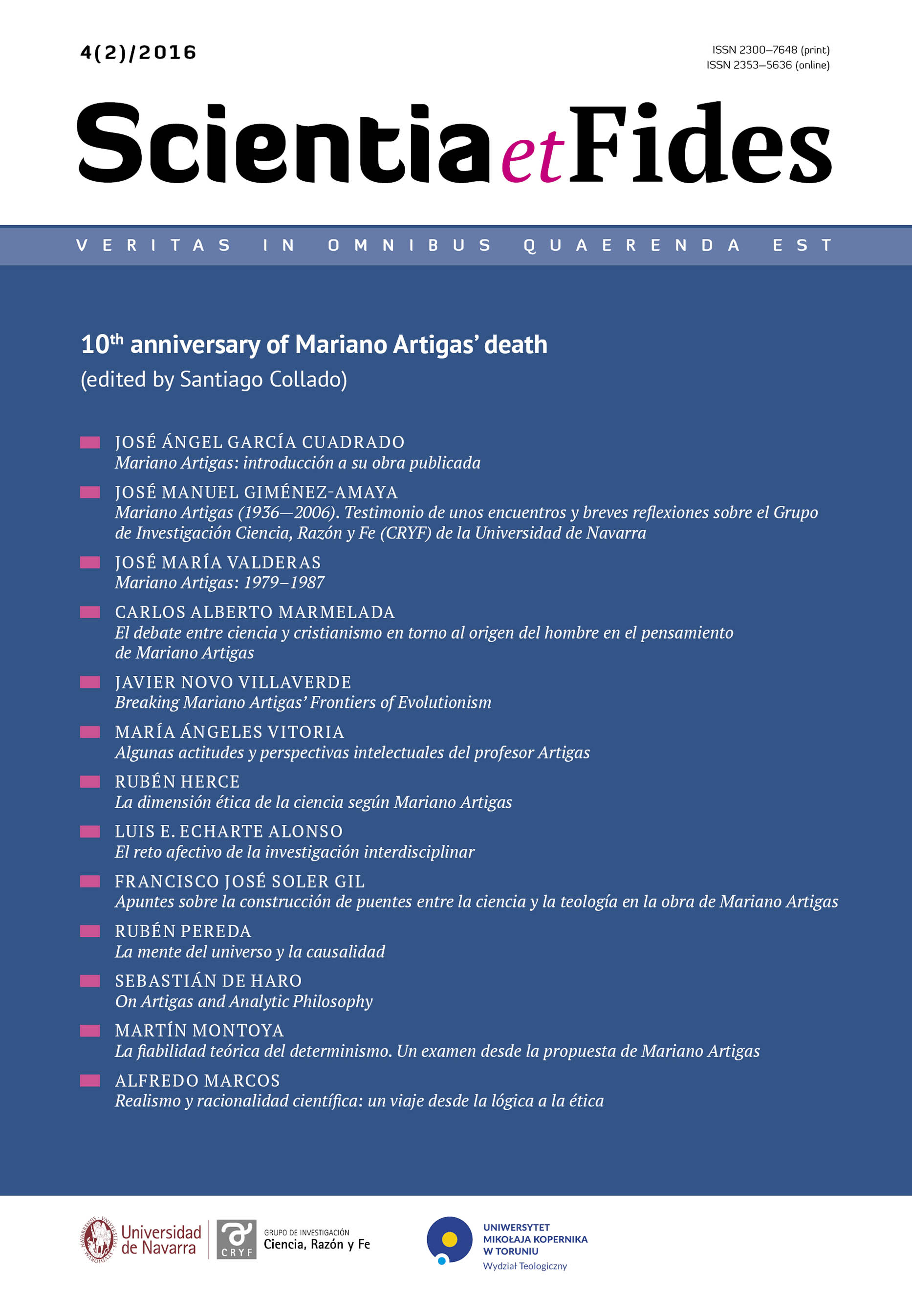Oracles, Prophets and the Exoteric Circles of Science and Religion
Schlagworte
Popularization of science, Mariano Artigas, Ludwig Fleck, science and religion, demarcation criteria, conflict thesisAbstract
Drawing upon Karl Giberson and Mariano Artigas’ joint book The Oracles of Science, I discuss the limits of an emphasis on so-called philosophical bridges in the relationship between science and religion. Epistemological and metaphysical analyses of the claims by scientists and religious people are indeed necessary to avoid illegitimate extrapolations; but a clear separation between scientific and religious statements is problematic. Following Ludwig Fleck’s characterisation of the esoteric and the exoteric circles of science, I argue that popularization of science is always embedded in scientific cultures and ideological agendas and that one cannot expect a clear demarcation criterion between pure science and pure popularization. I also consider Lyda Walsh’s rhetorical analysis of the scientists as prophets to understand the oracles’ public portrayal of science in pseudo-religious terms.Literaturhinweise
Barton, R. 1998. “'Huxley, Lubbock, and Half a Dozen Others’. Professionals and Gentlemen in the Formation of the X Club, 1851–1864”. ISIS, 89: 440–444.
Cunningham, A., and P. Williams. 1993. “De-centering the Big Picture: The origins of modern science and the modern origins of science.” British Journal for the History of Science 26:407–432.
Daston, L., and P. Galison. 2007. Objectivity. Cambridge, MA: The MIT Press.
Dawkins, R. 1998. “Postmodernism disrobed.” Nature 394:141–143.
Fleck, L. 1979. Genesis and Development of a Scientific Fact. Chicago: Chicago University Press. Originally published as Entstehung und Entwicklung einer wissenschaftlichen Tatsache. Einführung in die Lehre vom Denkstil und Denkkollektiv (Basel: Benno Schwabe und Co., 1935).
Giberson, K., y Artigas, M. 2007. Oracles of Science. Celebrity Scientist versus God and Religion. New York: Oxford University Press.
Giberson, Karl 2011. “When Science becomes Religion”, in Navarro, Jaume, ed., Science and Faith within Reason. Reality, Creation, Life and Design, (Farnham: Ashgate) 205—220.
Harrison, P. 2006. “‘Science’ and ‘Religion’: Constructing the boundaries.” The Journal of Religion 86:81–106.
Harrison, P. 2015. The Territories of Science and Religion. Chicago: Chicago University Press.
Levitt, P., and N. Gross. 1994. Higher Superstition. Baltimore: Johns Hopkins University Press.
Murillo, L. 1901. “La ciencia libre y la Revelación.” Razón y Fe 1:6–22.
Nieto-Galan, A. 2016. Science in the Public Sphere A history of lay knowledge and expertise. London: Routledge. Originally published as Los públicos de la ciencia. Expertos y profanos a través de la historia (Madrid: Marcial Pons, 2011).
Pius IX. 1870. Dei Filius. Last accessed June 21st. http://www.ccel.org/ccel/schaff/creeds2.v.ii.i.html
Sanz de Diego, R. M. 1998. “Una aportación regeneracionista de los jesuitas españoles: La revista Razón y Fe (1901).” Anuario Filosófico 31/1:147–177.
Shapin, S., and S. Schaffer. 1985. Leviathan and the Air-pump. Hobbes, Boyle and the Experimental Life. Princeton: Princeton University Press.
Sokal, A. 1996. “Transgressing the Boundaries: Towards a Transformative Hermeneutics of Quantum Gravity.” Social Text 46:215–252.
Sokal, A., and J. Bricmont. 1997. Impostures Intellectuelles. Paris: Editions Odile Jacob.
Stanley, M. 2015. “Huxley’s Church and Maxwell’s Demon. From Theistic Science to Naturalistic Science.” Chicago: Chicago University Press.
Topham, J. 1992. “Science and Popular Education in the 1830s: The Role of the Bridgewater Treatises.” British Journal for the History of Science 25:397–430.
Turner, F. M. 1974. Between science and religion: The reaction to scientific naturalism in late Victorian England. New Haven: Yale University Press.
Turner, F. 1978. “The Victorian conflict between science and religion: A professional dimension.” Isis 69:356–376.
Walsh, L. 2013. Scientists as Prophets. A Rhetorical Genealogy. Oxford: Oxford University Press.
Downloads
Veröffentlicht
Zitationsvorschlag
Ausgabe
Rubrik
Lizenz
CC BY ND 4.0. The Creator/Contributor is the Licensor, who grants the Licensee a non-exclusive license to use the Work on the fields indicated in the License Agreement.
- The Licensor grants the Licensee a non-exclusive license to use the Work/related rights item specified in § 1 within the following fields: a) recording of Work/related rights item; b) reproduction (multiplication) of Work/related rights item in print and digital technology (e-book, audiobook); c) placing the copies of the multiplied Work/related rights item on the market; d) entering the Work/related rights item to computer memory; e) distribution of the work in electronic version in the open access form on the basis of Creative Commons license (CC BY-ND 3.0) via the digital platform of the Nicolaus Copernicus University Press and file repository of the Nicolaus Copernicus University.
- Usage of the recorded Work by the Licensee within the above fields is not restricted by time, numbers or territory.
- The Licensor grants the license for the Work/related rights item to the Licensee free of charge and for an unspecified period of time.
FULL TEXT License Agreement
Stats
Number of views and downloads: 485
Number of citations: 0



